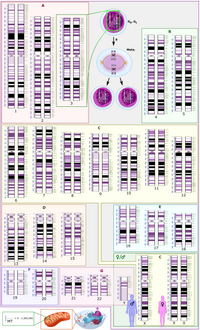
Photo from wikipedia
During meiosis, recombination between homologous chromosomes (homologs) generates crossovers that promote proper segregation at the first meiotic division. Recombination is initiated by Spo11-catalyzed double strand breaks (DSBs). 5’ end resection… Click to show full abstract
During meiosis, recombination between homologous chromosomes (homologs) generates crossovers that promote proper segregation at the first meiotic division. Recombination is initiated by Spo11-catalyzed double strand breaks (DSBs). 5’ end resection of the DSBs creates 3’ single strand tails that two recombinases, Rad51 and Dmc1, bind to form presynaptic filaments that search for homology, mediate strand invasion and generate displacement loops (D-loops). D-loop processing then forms crossover and non-crossover recombinants. Meiotic recombination occurs in two temporally distinct phases. During Phase 1, Rad51 is inhibited and Dmc1 mediates the interhomolog recombination that promotes homolog synapsis. In Phase 2, Rad51 becomes active and functions with Rad54 to repair residual DSBs, making increasing use of sister chromatids. The transition from Phase 1 to Phase 2 is controlled by the meiotic recombination checkpoint through the meiosis-specific effector kinase Mek1. This work shows that constitutive activation of Rad51 in Phase 1 results in a subset of DSBs being repaired by a Rad51-mediated interhomolog recombination pathway that is distinct from that of Dmc1. Strand invasion intermediates generated by Rad51 require more time to be processed into recombinants, resulting in a meiotic recombination checkpoint delay in prophase I. Without the checkpoint, Rad51-generated intermediates are more likely to be repaired using a sister chromatid, thereby increasing Meiosis I chromosome nondisjunction. This Rad51 interhomolog recombination pathway is specifically promoted by the conserved 5’-3’ helicase PIF1 and its paralog, RRM3 and requires Pif1 helicase activity and its interaction with PCNA. This work demonstrates that (1) inhibition of Rad51 during Phase 1 is important to prevent competition with Dmc1 for DSB repair, (2) Rad51-mediated meiotic recombination intermediates are initially processed differently than those made by Dmc1, (3) the meiotic recombination checkpoint provides time during prophase 1 for processing of Rad51-generated recombination intermediates. AUTHOR SUMMARY To sexually reproduce, cells containing two copies of each chromosome must undergo the specialized cell division of meiosis to sort the chromosomes into gametes containing a single copy of each chromosome. But how do homologous chromosomes know who is who? The answer is by recombination, a process in which double strand breaks on one chromosome are converted to single stranded ends that can search for the complementary sequence on the homolog. In yeast and mammals, this homology search involves binding of single strand ends by two highly conserved recombinases, Rad51 and the meiosis specific Dmc1. Rad51 is used in mitotic cells to repair breaks, primarily using sister chromatids as templates, while Dmc1 functions in meiosis to generate interhomolog crossovers. In budding yeast, Rad51 strand exchange activity is normally inhibited while Dmc1 is active. We show here that when Rad51 and Dmc1 are active at the same time, Rad51 competes with Dmc1 to mediate interhomolog recombination of a subset of double strand breaks. However, because Rad51- generated recombination intermediates take longer to process, there is a need to keep Rad51 inactive while interhomolog recombination is occurring.
Journal Title: PLOS Genetics
Year Published: 2022
Link to full text (if available)
Share on Social Media: Sign Up to like & get
recommendations!